Development of a High-Resolution Acoustic Sensor Based on ZnO Film Deposited by the RF Magnetron Sputtering Method
Abstract
1. Introduction
2. Acoustic Sensor Theory
3. Materials and Methods
4. Result and Discussion
5. Conclusions
Supplementary Materials
Author Contributions
Funding
Institutional Review Board Statement
Informed Consent Statement
Data Availability Statement
Conflicts of Interest
References
- Hoffmann, J.; Sathish, S.; Shell, E.B.; Fassbender, S.; Meyendorf, N. Acoustic imaging techniques for characterization of corrosion, corrosion protective coatings, and surface cracks. In Nondestructive Materials Characterization; Springer: Berlin/Heidelberg, Germany, 2004; pp. 294–322. [Google Scholar]
- Lee, T.H.; Kim, D.Y.; Jo, S.H.; Jeong, G.H.; Lee, S.G. Structural and electrical properties of (Na0.5K0.5)NbO3 ceramics with addition of BiTiO3. Trans. Korean Inst. Electr. Eng. 2011, 60, 2093–2096. [Google Scholar] [CrossRef][Green Version]
- Lee, W. Finite Element Analysis of the Piezoelectric Behavior of ZnO Nanowires. Korean J. Mater. Res. 2018, 28, 671–679. [Google Scholar] [CrossRef]
- Laurenti, M.; Perrone, D.; Verna, A.; Pirri, C.F.; Chiolerio, A. Development of a Flexible Lead-Free Piezoelectric Transducer for Health Monitoring in the Space Environment. Micromachines 2015, 6, 1729–1744. [Google Scholar] [CrossRef]
- Chen, Z.; Zheng, L.; Cao, W.; Chen, X.; Chen, R.; Li, R.; Shung, K.; Zhou, Q. High-Frequency Ultrasonic Imaging with Lead-free (Na,K)(Nb,Ta)O3 Single Crystal. Ultrason. Imaging 2017, 39, 348–356. [Google Scholar] [CrossRef]
- Olsson, R.H.; Tang, Z.; D’Agati, M. Doping of Aluminum Nitride and the Impact on Thin Film Piezoelectric and Ferroelectric Device Performance. In Proceedings of the 2020 IEEE Custom Integrated Circuits Conference (CICC), Boston, MA, USA, 22–25 March 2020; pp. 1–6. [Google Scholar]
- Kołodziejczak-Radzimska, A.; Jesionowski, T. Zinc Oxide—From Synthesis to Application: A Review. Materials 2014, 7, 2833–2881. [Google Scholar] [CrossRef]
- Wang, J.; Cao, J.; Fang, B.; Lu, P.; Deng, S.; Wang, H. Synthesis and characterization of multipod, flower-like, and shuttle-like ZnO frameworks in ionic liquids. Mater. Lett. 2005, 59, 1405–1408. [Google Scholar] [CrossRef]
- Özgür, Ü.; Alivov, Y.I.; Liu, C.; Teke, A.; Reshchikov, M.A.; Doğan, S.; Avrutin, V.; Cho, S.-J.; Morkoç, H. A comprehensive review of ZnO materials and devices. J. Appl. Phys. 2005, 98, 11. [Google Scholar] [CrossRef]
- Bhattacharyya, S.; Gedanken, A. A template-free, sonochemical route to porous ZnO nano-disks. Microporous Mesoporous Mater. 2008, 110, 553–559. [Google Scholar] [CrossRef]
- Ito, Y.; Kushida, K.; Sugawara, K.; Takeuchi, H. A 100-MHz ultrasonic transducer array using ZnO thin films. IEEE Trans. Ultrason. Ferroelectr. Freq. Control. 1995, 42, 316–324. [Google Scholar] [CrossRef]
- Suma, M.N.; Prasad, M.V.N.; Gaddam, V.; Rajanna, K.; Nayak, M. Development of a Novel Acoustic Sensor using Sputtered ZnO Thin Film. J. Pure Appl. Ind. Phys. 2019, 9, 1–7. [Google Scholar]
- Wang, P.; Du, H.; Shen, S.; Zhang, M.; Liu, B. Preparation and characterization of ZnO microcantilever for nanoactuation. Nanoscale Res. Lett. 2012, 7, 1–5. [Google Scholar] [CrossRef]
- Park, Y.W.; Shin, H.Y. A study on the ZnO piezoelectric thin film SAW filter for high frequency. J. Korean Ceram. Soc. 2003, 40. [Google Scholar] [CrossRef]
- Emanetoglu, N.W.; Gorla, C.; Liu, Y.; Liang, S.; Lu, Y. Epitaxial ZnO piezoelectric thin films for saw filters. Mater. Sci. Semicond. Process. 1999, 2, 247–252. [Google Scholar] [CrossRef]
- Cho, J.; Hwang, S.; Ko, D.H.; Chung, S. Transparent ZnO thin-film deposition by spray pyrolysis for high-performance metal-oxide field-effect transistors. Materials 2019, 12, 3423. [Google Scholar] [CrossRef]
- Vijayalakshmi, K.; Karthick, K.; Dhivya, P.; Sridharan, M. Low power deposition of high quality hexagonal ZnO film grown on Al2O3 (0001) sapphire by dc sputtering. Ceram. Int. 2013, 39, 5681–5687. [Google Scholar] [CrossRef]
- Nistor, M.; Millon, E.; Cachoncinlle, C.; Ghica, C.; Hebert, C.; Perrière, J. Nd-doped ZnO films grown on c-cut sapphire by pulsed-electron beam deposition under oblique incidence. Appl. Surf. Sci. 2021, 563, 150287. [Google Scholar] [CrossRef]
- Karthick, K.; Vijayalakshmi, K. Influence of Mg doping on the properties of ZnO films prepared on c-cut sapphire by sputtering. Superlattices Microstruct. 2014, 67, 172–180. [Google Scholar] [CrossRef]
- Karthick, K.; Srinivasan, D.; Christopher, J.B. Fabrication of highly c-axis Mg doped ZnO on c-cut sapphire substrate by rf sputtering for hydrogen sensing. J. Mater. Sci. Mater. Electron. 2017, 28, 11979–11986. [Google Scholar] [CrossRef]
- Lau, C.K.; Tiku, S.K.; Lakin, K.M. Growth of Epitaxial ZnO Thin Films by Organometallic Chemical Vapor Deposition. J. Electrochem. Soc. 1980, 127, 1843. [Google Scholar] [CrossRef]
- Zhang, Y.; Du, G.; Liu, B.; Zhu, H.; Yang, T.; Li, W.; Liu, D.; Yang, S. Effects of ZnO buffer layer thickness on properties of ZnO thin films deposited by low-pressure MOCVD. J. Cryst. Growth 2004, 262, 456–460. [Google Scholar] [CrossRef]
- Heo, Y.W.; Norton, D.P.; Pearton, S.J. Origin of green luminescence in ZnO thin film grown by molecular-beam epitaxy. J. Appl. Phys. 2005, 98, 073502. [Google Scholar] [CrossRef]
- Lee, H.J.; Park, K.H.; Kim, J.M.; Chang, S.M. Characteristics of ZnO Multi-Layer Film Fabricated by Electrodeposition Method. J. Korean Inst. Electr. Electron. Mater. Eng. 2017, 30, 705–709. [Google Scholar]
- Sinornate, W.; Mimura, H.; Pecharapa, W. Role of Sb-dopant on Physical and Optical Properties of ZnO Thin Film Deposited by Sol-gel-based Coating Method. Chiang Mai J. Sci. 2019, 46, 1001–1008. [Google Scholar]
- Wojnarowicz, J.; Chudoba, T.; Lojkowski, W. A review of microwave synthesis of zinc oxide nanomaterials: Reactants, process parameters and morphologies. Nanomaterials 2020, 10, 1086. [Google Scholar] [CrossRef] [PubMed]
- Mitra, P.; Chatterjee, A.P.; Maiti, H.S. ZnO thin film sensor. Mater. Lett. 1998, 35, 33–38. [Google Scholar] [CrossRef]
- Hammad, A.H.; Abdel-Wahab, M.S.; Vattamkandathil, S.; Ansari, A.R. Structural and optical properties of ZnO thin films prepared by RF sputtering at different thicknesses. Phys. B Condens. Matter 2018, 540, 1–8. [Google Scholar] [CrossRef]
- Kim, C.-S.; Park, I.-K. Review of Micro/Nano Nondestructive Evaluation Technique (II): Measurement of Acoustic Properties. J. Korean Soc. Nondestruct. Test. 2012, 32, 418–430. [Google Scholar] [CrossRef][Green Version]
- Miyasaka, C.; Park, I.K.; Park, T.S. Nondestructive Evaluation of Nanostructured Thin Film System Using Scanning Acoustic Microscopy. J. Korean Soc. Nondestruct. Test. 2010, 30, 437–443. [Google Scholar]
- Xu, C.; He, L.; Xiao, D.; Ma, P.; Wang, Q. A Novel High-Frequency Ultrasonic Approach for Evaluation of Homogeneity and Measurement of Sprayed Coating Thickness. Coatings 2020, 10, 676. [Google Scholar] [CrossRef]
- Yoshida, S.; Sasaki, T.; Usui, M.; Sakamoto, S.; Gurney, D.; Park, I.-K. Residual Stress Analysis Based on Acoustic and Optical Methods. Materials 2016, 9, 112. [Google Scholar] [CrossRef]
- Xi, X.; Li, X.; Miyasaka, C.; Kropf, M.; Tittmann, B. High frequency scanning acoustic microscopy as diagnostic tool in tissue science. J. Biotechnol. Biomater. 2013, 3. [Google Scholar] [CrossRef]
- Miyasaka, C. Acoustic microscopy applied to nanostructured thin film systems. In Modern Aspects of Electrochemistry No. 44; Springer: New York, NY, USA, 2009; pp. 409–450. [Google Scholar]
- Jensen, H.; Pedersen, J.H.; J⊘ rgensen, J.E.; Pedersen, J.S.; Joensen, K.D.; Iversen, S.B.; S⊘ gaard, E.G. Determination of size distributions in nanosized powders by TEM, XRD, and SAXS. J. Exp. Nanosci. 2006, 1, 355–373. [Google Scholar] [CrossRef]
- Sareecha, N.; Shah, W.A.; Anis-Ur-Rehman, M.; Mirza, M.L.; Awan, M.S. Electrical investigations of BaTiO3 ceramics with Ba/Ti contents under influence of temperature. Solid State Ionics 2017, 303, 16–23. [Google Scholar] [CrossRef]
- Lim, J.; Lee, C. Effects of substrate temperature on the microstructure and photoluminescence properties of ZnO thin films prepared by atomic layer deposition. Thin Solid Films 2007, 515, 3335–3338. [Google Scholar] [CrossRef]
- Singh, S.; Srinivasa, R.S.; Major, S.S. Effect of substrate temperature on the structure and optical properties of ZnO thin films deposited by reactive rf magnetron sputtering. Thin Solid Films 2007, 515, 8718–8722. [Google Scholar] [CrossRef]
- Oks, E.M.; Tyunkov, A.V.; Yushkov, Y.G.; Zolotukhin, D.B. Ceramic coating deposition by electron beam evaporation. Surf. Coat. Technol. 2017, 325, 1–6. [Google Scholar] [CrossRef]
- Surmenev, R.; Vladescu, A.; Surmeneva, M.; Ivanova, A.; Braic, M.; Grubova, I.; Cotrut, C.M. Radio Frequency Magnetron Sputter Deposition as a Tool for Surface Modification of medical implants. In Modern Technologies for Creating the Thin-Film Systems and Coatings; InTech: London, UK, 2017; pp. 213–248. [Google Scholar]
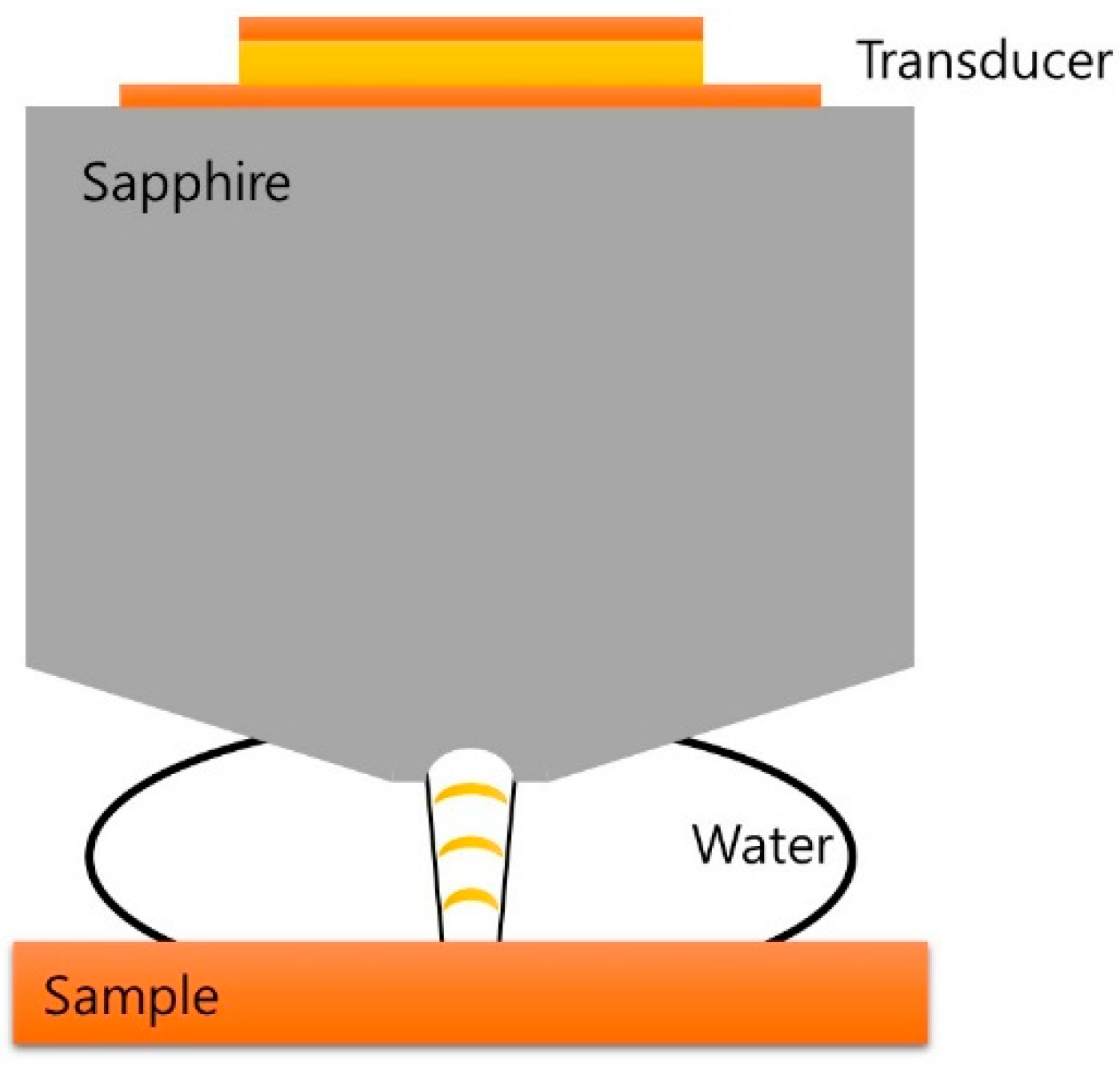
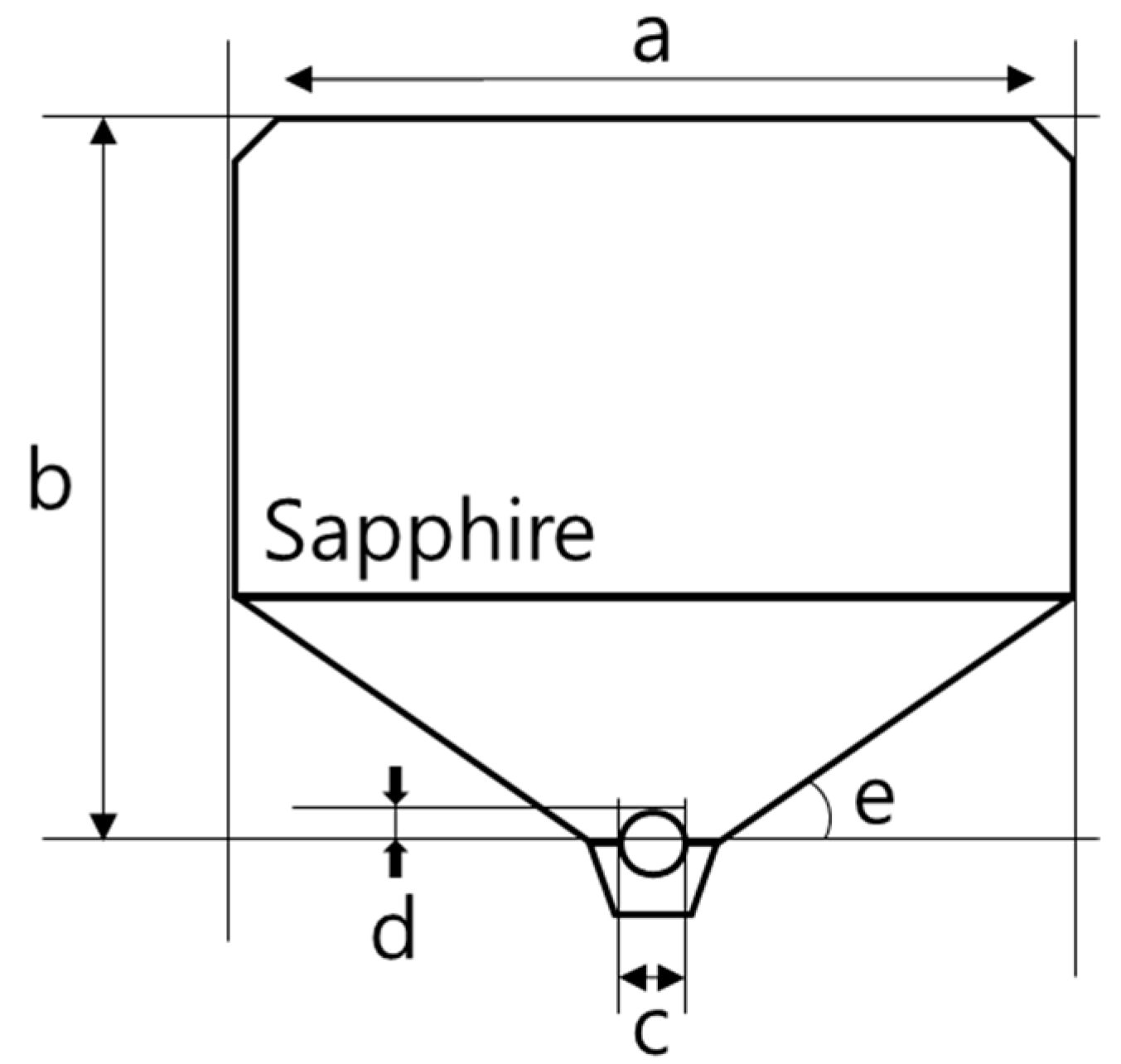




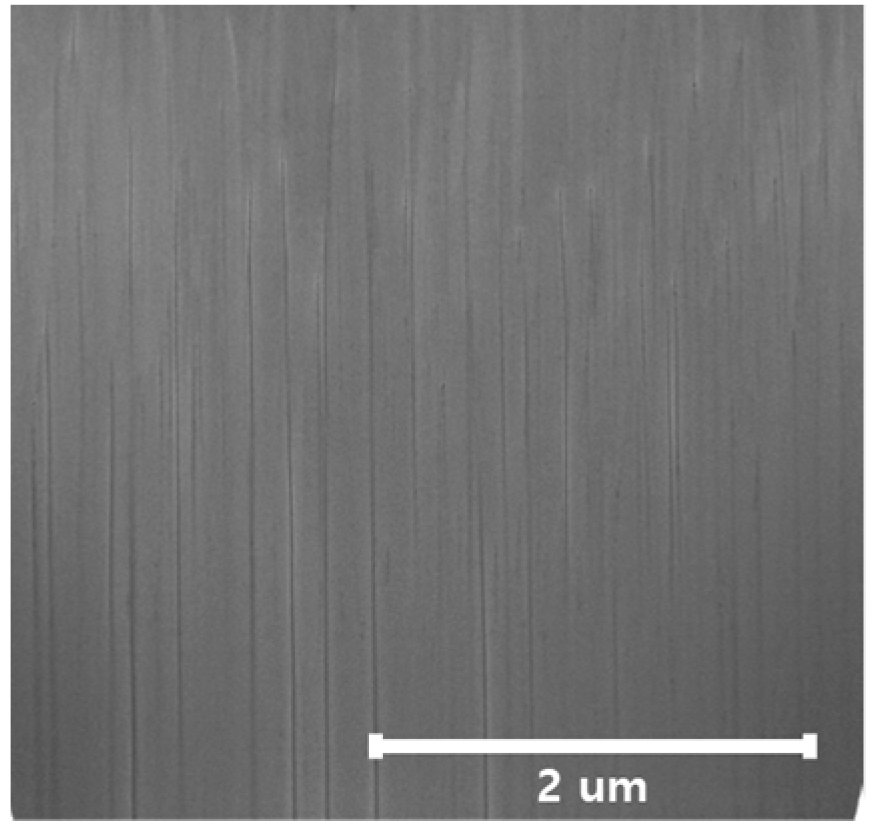
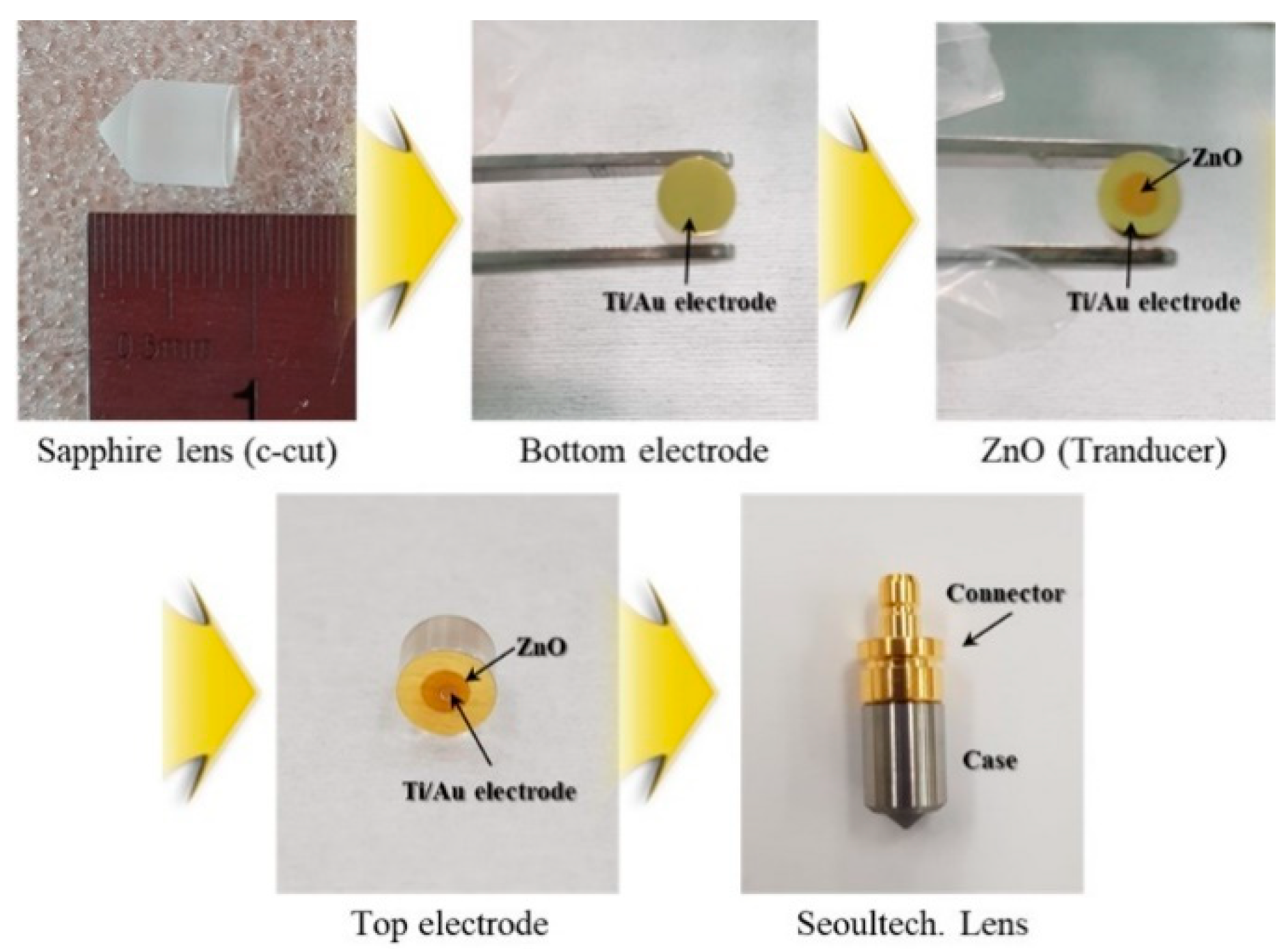
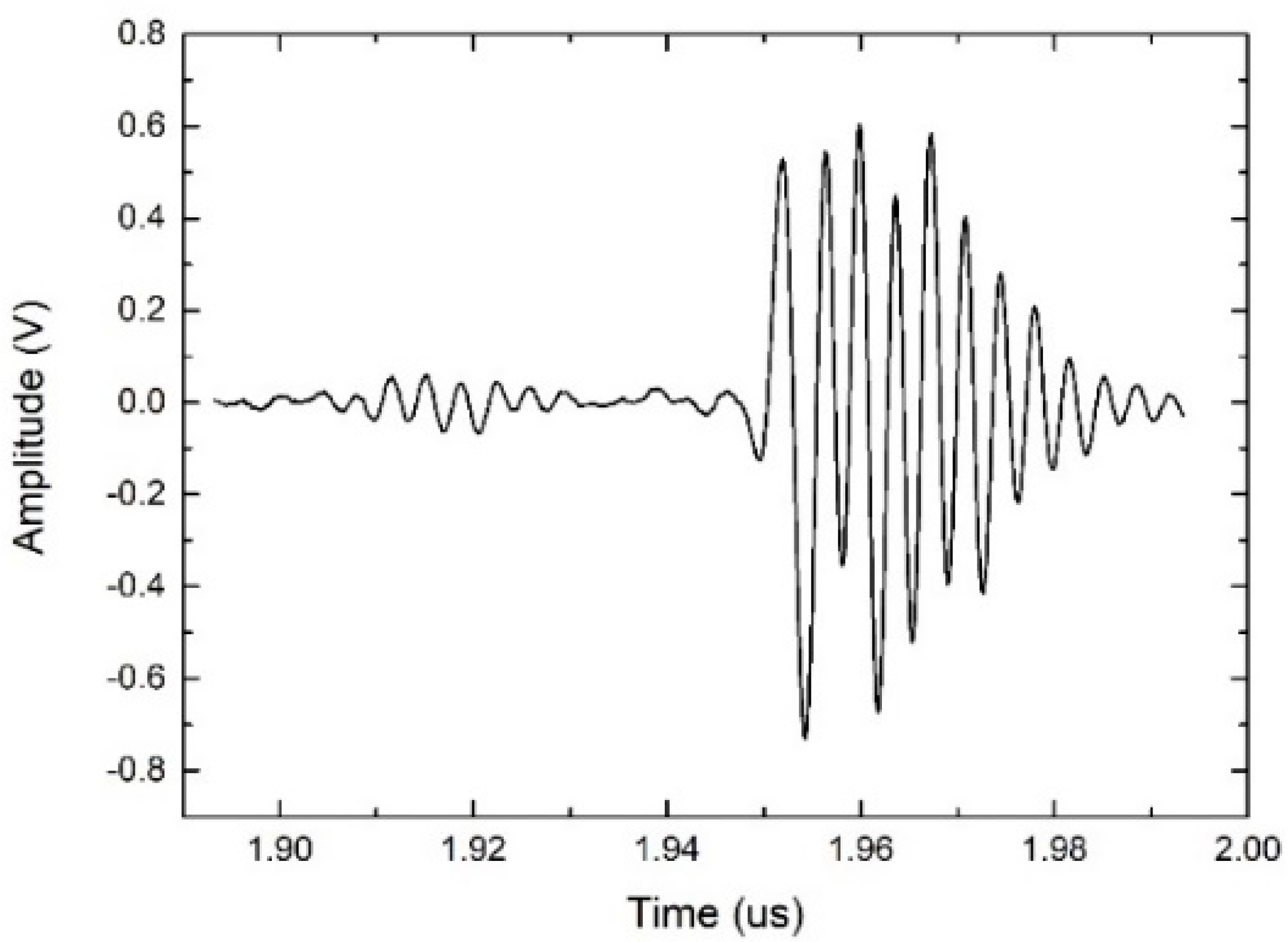
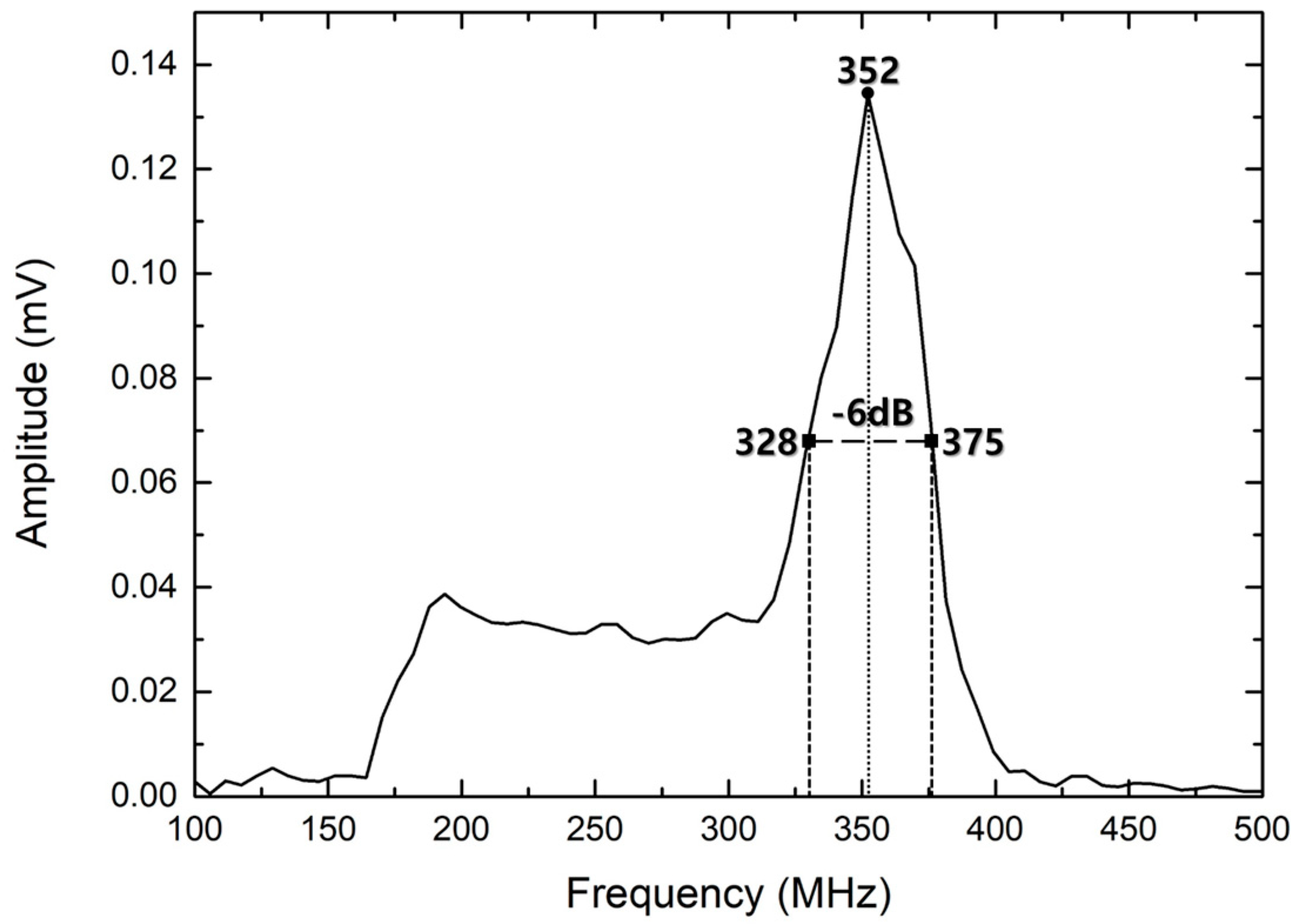
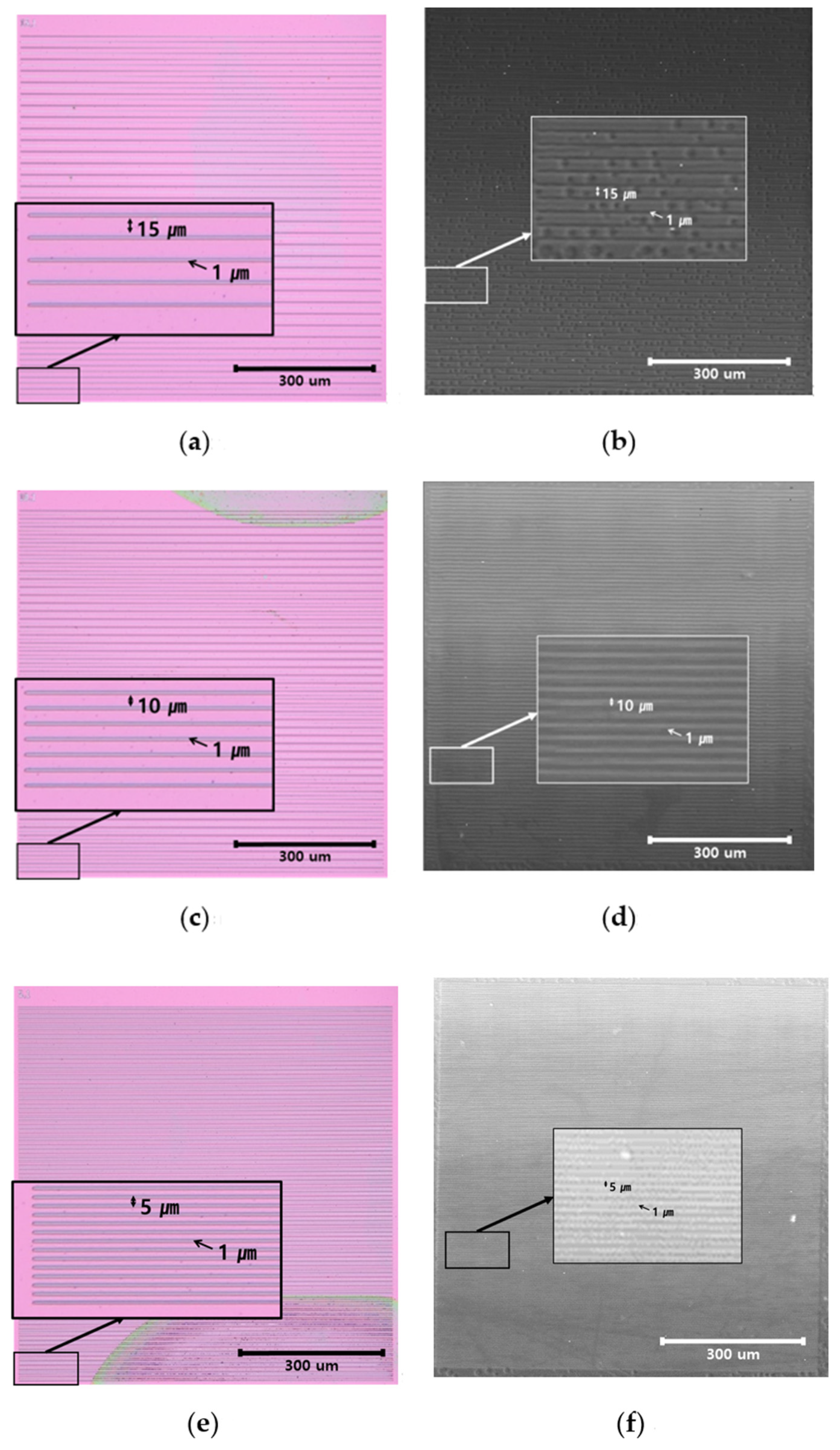
| a | b | c | d | e | |
|---|---|---|---|---|---|
| Diameter | 6.1 ± 0.005 | 6.45 ± 0.005 | 0.866 ± 0.005 | 0.25 ± 0.005 | 40° |
| Bottom Electrode | Transducer | Top Electrode | |||
|---|---|---|---|---|---|
| Material | Ti | Au | ZnO | Ti | Au |
| Thickness | 10 nm | 150 nm | 5.1 µm | 50 nm | 250 nm |
| Diameter | 6 mm | 6 mm | 3 mm | 1 mm | 1 mm |
Publisher’s Note: MDPI stays neutral with regard to jurisdictional claims in published maps and institutional affiliations. |
© 2021 by the authors. Licensee MDPI, Basel, Switzerland. This article is an open access article distributed under the terms and conditions of the Creative Commons Attribution (CC BY) license (https://creativecommons.org/licenses/by/4.0/).
Share and Cite
Kang, D.-C.; Kim, J.-N.; Park, I.-K. Development of a High-Resolution Acoustic Sensor Based on ZnO Film Deposited by the RF Magnetron Sputtering Method. Materials 2021, 14, 6870. https://doi.org/10.3390/ma14226870
Kang D-C, Kim J-N, Park I-K. Development of a High-Resolution Acoustic Sensor Based on ZnO Film Deposited by the RF Magnetron Sputtering Method. Materials. 2021; 14(22):6870. https://doi.org/10.3390/ma14226870
Chicago/Turabian StyleKang, Dong-Chan, Jeong-Nyeon Kim, and Ik-Keun Park. 2021. "Development of a High-Resolution Acoustic Sensor Based on ZnO Film Deposited by the RF Magnetron Sputtering Method" Materials 14, no. 22: 6870. https://doi.org/10.3390/ma14226870
APA StyleKang, D.-C., Kim, J.-N., & Park, I.-K. (2021). Development of a High-Resolution Acoustic Sensor Based on ZnO Film Deposited by the RF Magnetron Sputtering Method. Materials, 14(22), 6870. https://doi.org/10.3390/ma14226870






